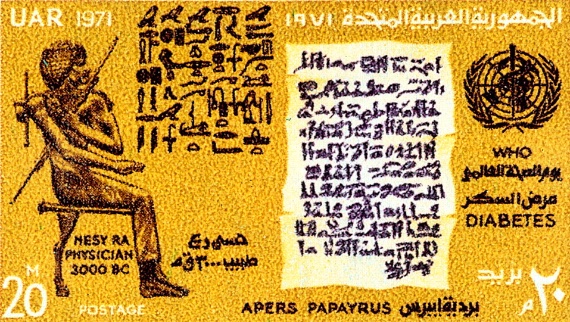Some 2,500 years ago, Indian doctors observed that the urine of certain people attracted flies and ants because of its sweetness. They called it madhumeha, “honey urine”, noting that those affected suffered from severe thirst and bad breath. Except for a possibly older reference in an Egyptian papyrus, this may be the earliest documented reference to diabetes, one of the world’s most common non-communicable diseases: according to the World Health Organization it affects some 422 million people worldwide, a figure that has been growing steadily in recent decades. And although it still kills 1.5 million people every year, compared to the almost certain death sentence it carried in ancient times, its history is arguably one of medicine’s greatest success stories in making a deadly disease chronic, all thanks to one key discovery: insulin.

In the monumental library of the University of Leipzig in Germany, one of the documents competing for the title of the oldest medical treatise is preserved. The Ebers Papyrus, named after the Egyptologist who brought it to light, contains hundreds of prescriptions for various ailments. One of them was intended to cure excessive urination (polyuria), a condition in which some experts have interpreted as a reference to diabetes. A description of the disease appears more clearly in the Indian texts of Ayurvedic medicine attributed to the authors Sushruta, Charaka and Vagbhata, who distinguished between what we now call diabetes types 1 and 2. The allusion to the sweetness of the urine (glycosuria) is an unmistakable sign that was also picked up by Chinese medicine. Interestingly, this symptom escaped the Hippocratic physicians of ancient Greece, but the abundance of urine gave the disease its present name: diabetes, which in Ionian Greek meant “to pass through”. The term was probably coined by the physiologist Demetrius of Apamea in the second to first century BC.
[+] Watch Fullscreen
The path to the origin of diabetes
Although the disease was frequently reported by Greco-Roman physicians such as Galen and medieval authors in the West and East, it was not until 1674 that a European physician, the English physician Thomas Willis, noted in a scientific work, Pharmaceutice rationalis, the sweet taste of the urine of diabetics, as verified by himself. He coined the term diabetes mellitus, adding the latter Latin word which means “honey-sweet”. In 1776 Matthew Dobson showed the presence of sugar in the urine of diabetics, and in 1797 John Rollo applied the first significant dietary approach to treating what would later be called type 2 diabetes. In 1915, Frederick Allen and Elliott Joslin began experimenting with a low carbohydrate fasting diet.

However, none of these early breakthroughs came close to pinpointing the origin of the disease; a kidney condition was the most common guess, although Willis attributed it to the blood. Various scientists observed alterations in the pancreas at autopsy, but it was not until the 19th century that the experiments and observations of Joseph von Mering, Oskar Minkowski and others confirmed that the dysfunction of this organ, involved in digestion, caused the disease. Furthermore, microscopic study led to the recognition of the role of the islets of Langerhans, masses of cells located within the pancreas that were first observed by the German pathologist Paul Langerhans in 1869. Gradually, it was realised that the pancreas also had an endocrine function regulating blood glucose, and that its failure forced the kidneys to work hard to eliminate it, leading to abundant urination, dehydration and thirst.
The struggle to isolate insulin
What was missing was the essential ingredient that the pancreas supplied to the body, the absence of which caused diabetes. If we go by the history of the Nobel prizes, in 1921 Frederick Banting and John James Rickard Macleod discovered and isolated insulin at the University of Toronto, and the following year they treated the first patient. For this discovery, in 1923 they were both awarded the Nobel Prize in Physiology or Medicine.
The reality was more complicated: Banting worked in Macleod’s laboratory with the help of Macleod’s undergraduate student Charles Best as lab assistant. For the purification of crude pancreatic extracts from dogs and cows, they were assisted by the biochemist James Collip. But a bitter feud developed between Banting and Macleod. When both were awarded the Nobel Prize, Banting was incensed at their disregard for his collaborator Best, to whom he donated half of the prize, and Macleod did the same to Collip. In subsequent decades, Banting and Best tried to play down the merits of Macleod and Collip, until independent reviews of history divided the credit for the discovery among the four.

But it was even more complicated: in Romania, Nicolae Paulescu had obtained, eight months before the Canadians, an extract he called “pancreine” that lowered blood glucose. Paulescu’s work was not recognised at the time, even though Banting and Best knew about it, but the Romanian’s enthusiastic anti-Semitism and Christian ultra-nationalism eventually erased his work from the map.
With insulin now identified and isolated, further research brought salvation for diabetes sufferers. Almost immediately, the pharmaceutical company Eli Lilly and Company marketed the hormone to the general public, and in the 1940s the Novo Nordisk company launched the first long-acting insulin. In 1951 and 1952, Frederick Sanger deciphered the amino acid sequence of insulin, the first of a protein, allowing it to be produced by chemical synthesis. In 1969, Dorothy Hodgkin determined its structure by X-ray crystallography. These findings facilitated the mass production of bovine and porcine insulin, until 1982, when Genentech and Eli Lilly launched human insulin (under the brand name Humulin) generated in genetically engineered bacteria, the first commercial protein obtained in this way. Since then, different formulations—fast, medium or slow acting—have been introduced, along with insulin analogues and other drugs that keep at bay the symptoms of one of the diseases that has benefited most from scientific progress.
Comments on this publication